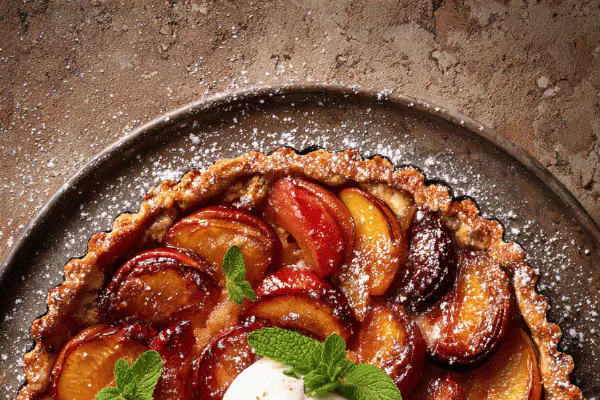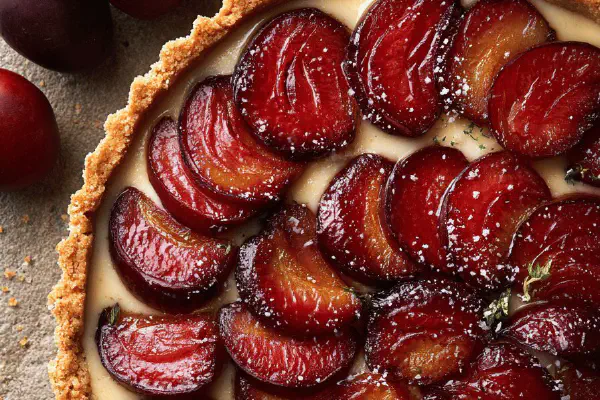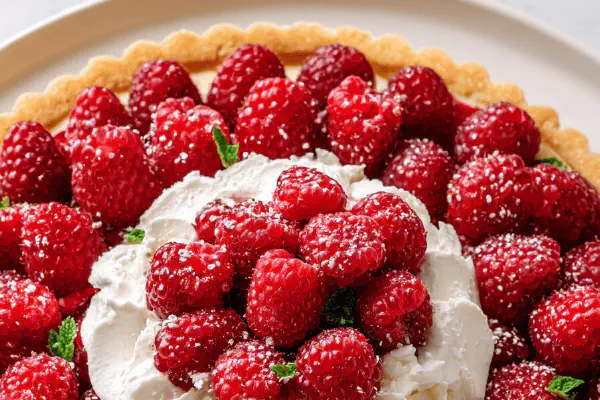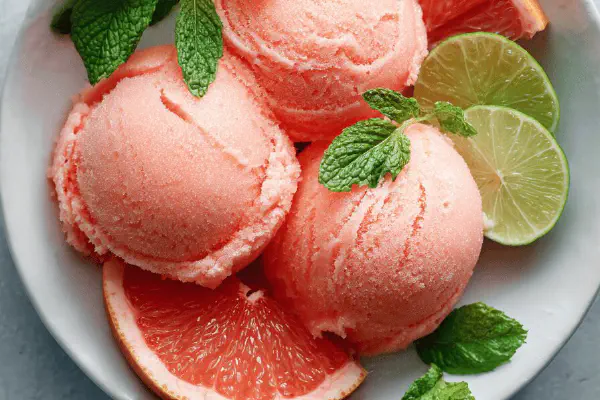Rustic Stone Fruit Tart

By Emma
Certified Culinary Professional
Ingredients
Crust
- 215 g (1 1/2 cups minus 1 tbsp) all purpose flour
- 23 g (2 1/2 tbsp) powdered sugar
- 5 ml (1 tsp) baking powder
- 1 ml (1/4 tsp) salt
- 110 g unsalted butter, cold diced
- 60 ml plain yogurt
- 15 ml lemon juice (freshly squeezed, replaces part of water)
- Milk, for brushing
- Sugar, for sprinkling
Fruit
- 1 kg (6 cups) thinly sliced nectarines, peaches, apricots
- 100 g (1/2 cup minus 1 tbsp) sugar
- 6 ml (1 1/4 tsp) cornstarch
About the ingredients
Method
Crust
- 1. Position rack center oven. Preheat to 215°C (420°F). Line baking sheet with parchment.
- 2. Pulse flour, sugar, baking powder, salt in food processor just to mix. Add butter; pulse until bits resemble coarse peas, some pea size bits okay but avoid overmixing or too crumbly.
- 3. Pour yogurt and lemon juice; pulse briefly. Watch dough – stops clumping? Add 5 ml cold water only if dry. Handle quickly. Form a disk — don't overwork; warm hands ruin texture.
- 4. Dust surface, roll dough gently into 35 cm (13.5 in) circle. Don’t worry about perfect edges.
- 5. Transfer dough carefully to pan using rolling pin or hands. Chill 10 mins if too soft to handle.
Fruit
- 6. Toss sliced fruits with sugar and cornstarch in large bowl. Let sit to macerate and release juice, 5 minutes max or fruit mush.
- 7. Heap fruits to center of dough, leaving 5 cm (~2 in) border bare. Fruits pile high but balanced to avoid sogginess.
- 8. Fold edges up and over fruit, pleating dough every 5 cm to gather and partially enclose filling. No seal needed; rustic look preferred.
- 9. Brush dough edges with milk, sprinkle sparkling sugar generously over crust for crunch and shine.
- 10. Bake 28 - 32 mins, adjust time slightly based on oven patterns. Look for golden crust edges, bubbling fruit juices visible through folds, slight caramelization. Listen for gentle crackling edges.
- 11. Remove when crust is deep golden but not burnt, fruit softened but not collapsed.
- 12. Cool intentionally a bit so juices thicken; serve warm or slightly cooled with plain yogurt (for breakfast vibe) or vanilla ice cream (dessert style).
Cooking tips
Chef's notes
- 💡 Cold butter diced small chunks, not melted or soft. Overmix and crumbly ruins crust - pulse short bursts in processor. Dough just clumping, spots of flour okay. Roll gently, dust minimal flour or dough dries and cracks folding edges. I skip water unless dough looks dry, then add teaspoon slow. Lemon juice helps relax gluten, bright crust without stiffness. Don’t skip chilling if dough soft; hands warm ruin texture fast. Rustically pleated edges trap fruit but open so juices bubble out, no sealed rim here.
- 💡 Fruit slices must be thin for even cooking. Toss with exact sugar and cornstarch ratio, more cornstarch toughens but too little soggy too fast. Macerate briefly max 5 minutes or fruit releases juice too quick. Heap fruit high but balanced so no soggy bottom; fats in crust and yogurt cut fat so crust holds structure. Watch oven, 215°C high heat caramelizes edges fast but crackling sound signals doneness, listen close. Rotate tray halfway if oven spots hot.
- 💡 Milk brushing crust edges helps sugar stick and browns crust nicely. Whole milk richer, dairy-free can use unsweetened almond milk. Sprinkle sparkling sugar generously after brushing, adds crunch and shine. Don’t seal edges, rough pleats sag cold but bubble open in oven. Dough rests 10 mins in fridge if too soft to handle - this saves folding disasters. Keep timing close, longer bake dries fruit into mushy mess versus juicy soft.
- 💡 Backup plans: No processor? Rub cold butter into flour fingertips fast till pea size bits. No powdered sugar? Blitz granulated sugar briefly in grinder or processor to powder. Sour cream swap for yogurt possible, adds richness but heavier dough, possibly denser crust. If fruit soggy, toss bit more cornstarch cautiously. Frozen fruit? Use more cornstarch, less sugar for excess moisture control.
- 💡 If dough cracks during roll or fold, press gently sealed with fingers or patch with scraps. Dough slightly sticky, cold hands help. Dough too dry add water teaspoon at time only; too wet dust more flour and chill. To avoid soggy crust chill dough longer or pre-bake crust 5 mins before fruit fill. Rustic look tolerates imperfections; folds imperfect but charm. Serve just warm with yogurt or vanilla ice cream cold – contrast hits right texture and temperature notes.
Common questions
Why add lemon juice to dough?
Adds brightness, relaxes gluten so dough rolls easier, avoids stiff crumb. Skip if want denser texture but crust might feel tougher. Works better than water here.
Can I use frozen fruit instead of fresh?
Yes but frozen adds moisture. Increase cornstarch, reduce sugar slightly. Toss fruit frozen or partially thawed but drain excess. More cornstarch stops soggy bottom but don’t overdo or filling gets gummy.
How to tell crust done without burning?
Listen for crackling sounds, bubbling fruit juice through folds. Edges golden deep but not burnt. If burning too fast, lower oven temp 5-10 degrees or rotate tray mid-bake. Visual and sound cues beat timers.
Best way to store leftovers?
Store cooled tart loosely covered fridge few days. Reheat gentle, not microwave to keep crust from sogging. Avoid freezing if can; crust soggy after thaw. Next day cold great with yogurt breakfast style.



